Methodology for a Decision Support Tool for a Tidal Stream Device
MSc Sustainable Engineering: Offshore Renewable Energy


Tidal Technologies
As harnessing power from tides is a relatively new method of power generation, there have been a variety of different technologies that have been tried, tested, and some discarded in the attempt to reach an optimum solution for extracting power from the tides. Tidal technologies can be split into two main categories. The first harnesses the tidal flow to generate power and the second uses changes in tidal surface heights to create an imbalance that can be converted into a controlled flow.
Flow Devices
Devices that can harness the flow of the tidal stream are generally freestanding devices connected to the seabed either on pilings or by their own weight. They share many of the characteristics of wind turbine farms with a large number of tidal devices placed in an optimum location to harness the tidal flow. This makes use of the economies of scale when installing, maintaining, and exporting electricity to the main grid.
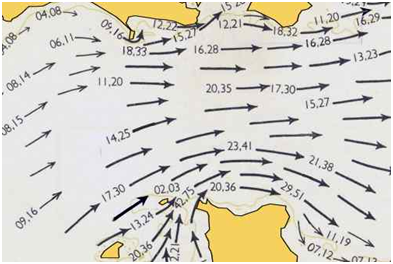
Tidal Stream Chart, Photograph – N Weller
Rotor devices
Subsea Devices
There have been many different attempts to build a successful bladed tidal device. In general, the larger devices have a large rotor diameter and are mounted to the seabed, with a nacelle and blades that rotate to face the optimum direction. This basic set up can then be modified with a variety of different designs including twin contra rotating rotors to deconstruct vibrations. Upstream and downstream rotors mounted to the stator and rotor of a generator to eliminate the need for a gearbox just to state a few variations that have been made to the design.
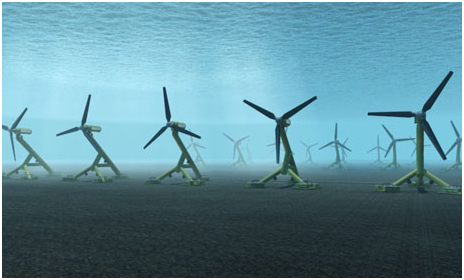
Sea tidal farm, Photograph – Scottish Power Renewables
Semi-submersible/submersible devices
These devices are normally smaller in diameter than the seabed mounted technology, but this gives them an advantage in installation and maintenance solutions. Most semi-submersible devices are tethered to the sea bed like a conventional mooring buoy with a series of small turbines connected onto the mooring cables. This system means that smaller ships can be used to recover the smaller turbines and, in case of breakdown or to carry out regular maintenance, the entire turbine can be disconnected and removed from the water to simplify the maintenance process. For the semi-submersible turbines, the turbine is much like a conventional vessel except that the propeller is used to harness power rather than propel the ship. By having the turbine tethered and having access to the inside of the turbine through the hull it will be possible to increase the reliability with this kind of design. The problem with the semi-submersible comes from the wave and tidal interactions as it is not feasible to get the rotors deep enough in the water to isolate them from the effects of the waves.
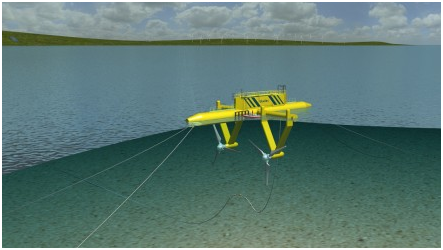
Semi-Submersible turbine, Photograph – BlueTEC
Oscillator devices
This form of tidal power generator uses the flow over a foil to cause the foil to raise and lower an arm around a pivot point with the opposite end of the arm connected to a pump. This can then be used to pump hydraulic fluid to turn a generator either onshore or on the device. If the generator is onshore it eliminates the complex problem of using electrical devices offshore.
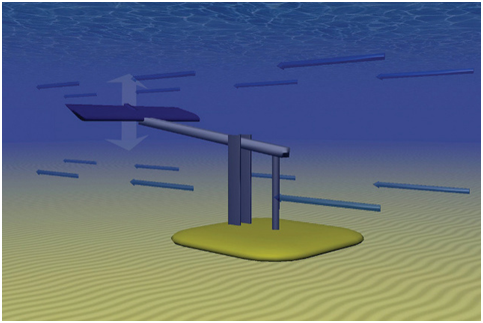
Oscillating tidal device, Photograph - Engineering and Technology Magazine
Tidal Barrage
A tidal barrage is a tidal device that works much like a conventional hydro power station. In a tidal barrage there is a barrage with turbines built into the bottom of them when there is a large difference in height, caused by the tides, between the sea and lagoon sides of the barrage, then the louvers are opened and the water is allowed to flow through the turbines until the water level is equal. The louvers are then closed until the tidal state has changed and the process can be reversed.
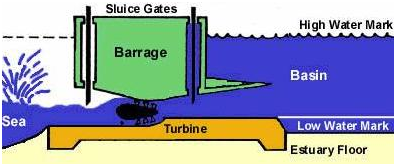
Tidal Barrage, Photograph - Renewable Energy UK
The main problem with the tidal barrage system is the environmental effects. It has been found from the few tidal barrages built that they can generate huge amounts of renewable energy, but there are severe costs to the environment caused by the flooding of the basin. This flooding effect changes the often delicate ecosystems that exist in the intertidal ranges such as salt water marshes and dune systems. These environments are often very important to migrating birds.